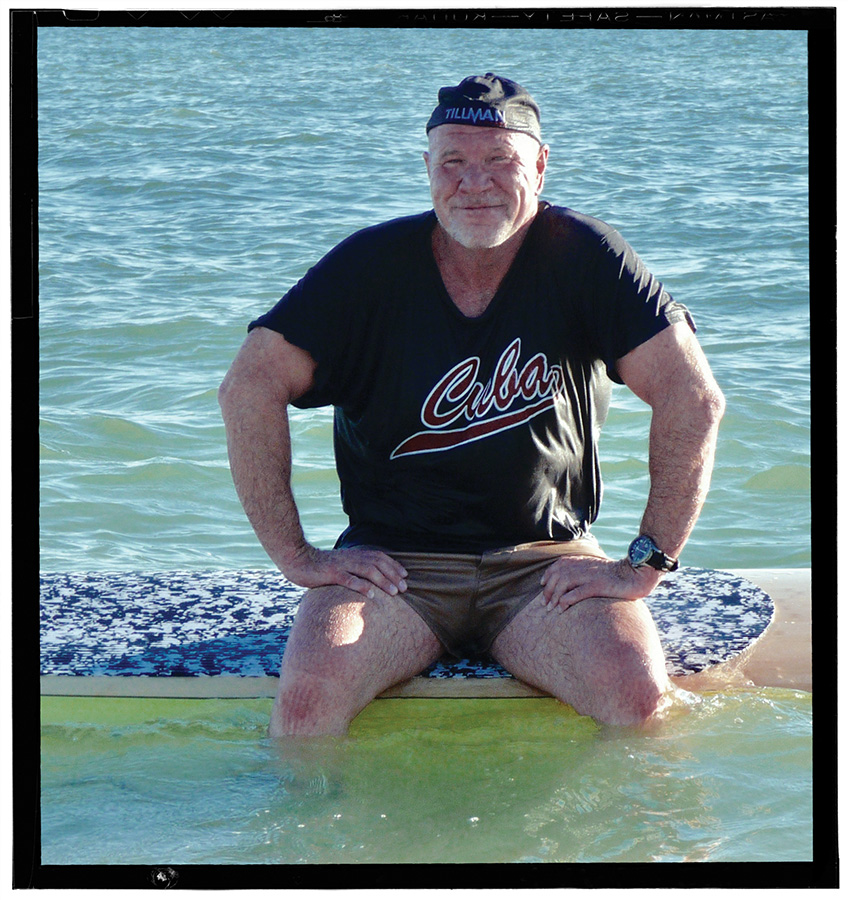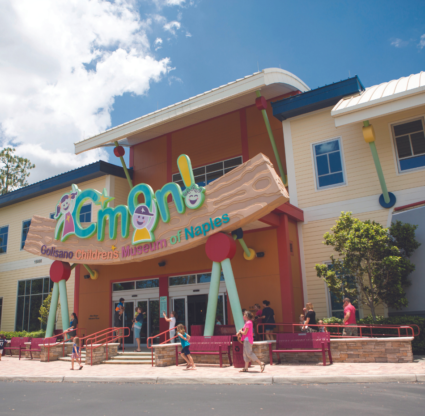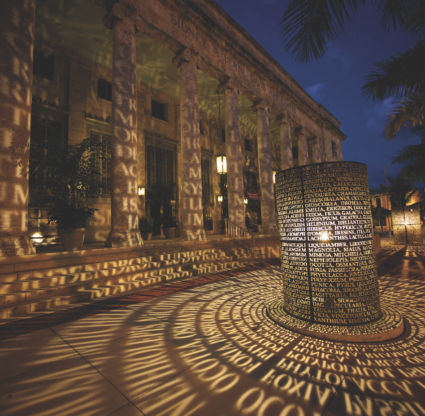The first day I meet Randy Wayne White, he’s at Doc Ford’s Rum Bar & Grille on Captiva, signing copies of Caribbean Rim, his latest novel, for some three hours worth of fans. There are framed poster-size copies of various book jackets throughout, including, of course, Sanibel Flats, his first. If you’ve been around Southwest Florida for any length of time, this is the Randy Wayne White you’re likely familiar with—the prolific, best-selling novelist who sets his mystery and adventure tales here and whose biologist/former special agent protagonist is the namesake behind three successful restaurants. That’s about all I knew about White, too, until I discovered the nonfiction works chronicling the author’s real-world escapades: brushes with sharks and with voodoo; an illicit
visit to a Guatemalan temple; a search for the mythical “Gatorman”; the time he got stabbed in Peru, the time his hotel was blown up in Peru (yes, same trip, and, no, he doesn’t go there anymore).
Sorry, Randy, I’m bypassing Doc. You are the better character.
As White celebrates the release of Caribbean Rim, his 25th Doc Ford novel, published earlier this year, we dig into a biography of Southwest Florida’s most prolific author—and discover a page-turning tale.
I meet up with White again two days later, this time at the home on Sanibel he shares with his wife, songwriter Wendy Webb. The book tour is over, and White is preparing for an extended trip abroad. He takes me around the office, a bright, breezy space carved out of an oversize first-floor garage; through an undeveloped parcel next door; and upstairs to the house where I chat with Wendy.
White, who got his start as a journalist, knows exactly the kinds of details a magazine writer wants to see, and without prompting he points out his well-worn catcher’s mitts; assorted baseball gear that he’ll bring to poor kids in Cuba; the old-fashioned typewriter upon which he wrote Sanibel Flats; the framed poster advertising “Hunter S. Thompson for Sheriff!” for his pal’s 1970 campaign. (On the day Thompson first met the barrel-chested, ruddy-complexioned White, he reportedly gasped, “Jesus Christ, you’re even scarier looking than people say!”) There are myriad fishing poles, a nod to White’s days as a commercial guide; photos taken by Raul Corrales, Fidel Castro’s official photographer; a sign culled from the Nicaraguan ministry. He won’t say how he came to possess it.
I was starting to see just how blurred was the line between real and imagined in the world of Randy Wayne White. Our trek to the adjacent lot cinched it.
For a man who spent much of his life squatting behind home plate, White, surprisingly, moves nimbly through the brush. He stops and nods in the direction of a slender tree growing in a plastic pot.
“Go take a look,” White invites. “What do you notice about that citrus?” The leaves looked lush and green, almost waxy in their sheen. They obscured what I didn’t see at first—2-inch-long thorns sprouting from its branches. I am puzzled. He explains: The orange tree may be a direct descendant of the trees introduced to the New World by Spanish explorers in the 1500s.
“We found it in a place so remote, no one could have been there for hundreds of years,” White says.
I am still puzzled.
“It started as a plot line in a novel,” he says. White’s 2016 book Seduced, the fourth in his Hannah Smith series, focuses on citrus greening, the disease that is currently threatening the state’s signature crop. Hannah ponders whether the rootstock introduced by the Spaniards might be more resilient to greening than the hybridized, genetically altered trees growing throughout commercial groves today. Archaic Spanish citrus originated in Asia; the fly that’s carrying the disease is the Asian citrus psyllid. She searches for it, with a trail of bad guys and much danger in her wake.
White decided to explore the veracity of his plot line. Along with his son and a couple of pals, the writer embarked on a machete-wielding, python-encountering, mosquito-battling trek into the state’s wild interior looking for an age-old citrus.
“And we found it. Unbelievable.”
What’s that saying about art imitating life?
When White publicly tells the story of his transformation from Sanibel Island fishing guide to crime novelist, as he did during the book signing of Caribbean Rim, he offers this abridged version:
“For more than 13 years, I was a full-time fishing guide on Tarpon Bay on Sanibel. … In 1987 or ’88, the federal government came to us … and told us, ‘In two months, we’re closing Tarpon Bay to power boat traffic.’ We were out of a job. And I am not qualified for anything. I mean, not qualified. So I wrote a novel called Sanibel Flats…”
The real story of White’s writing journey is far more detailed.
The writer spent his boyhood on a farm in rural Pioneer, Ohio. “I know boredom is often criticized as a catalyst for trouble; for me, it was a catalyst for freakin’ boredom,” White says. He joined 4H as any good farm kid might do, but what he loved best were trips to the library with his mom. White’s mother comes from a poor North Carolina family that spent little time in formal education but a whole lot of time reading books. “They had a major influence on me—they were amazing storytellers, and funny. My God, they were funny,” says White, who spent his boyhood summers with his relatives in North Carolina. “I would laugh until I had to get off the porch and do something.”
He lights up when I ask about the authors that inspired him: Steinbeck, Faulkner, Hemingway, Marjorie Rawlings and “her wonderful ability to share a sense of place,” and Joseph Conrad, “Holy goodness, the rhythms of those sentences!” Ralph Waldo Emerson’s essays “changed his life”; Sherlock Holmes lent adventure to a quiet childhood.
He remembers distinctly the day when he was about 11 or 12, standing “in the corn stubble in the middle of nowhere” and deciding what he wanted to be when he grew up. “I remember writing it down,” he says. “A writer. I probably spelled it with two ‘t’s.’ I thought if I could write a book, maybe I could become part of the magic I found in books. I never thought I was smart enough, and certainly wasn’t qualified, but I worked very hard at it. Still do.”
He’s about as unlikely a writer as one could meet. Once, the principal of White’s high school alma mater looked up the novelist’s academic records before White’s guest appearance. The administrator confessed his sleuthing and then asked bewilderedly: “How could you have done so poorly?”
To which, White says he responded: “‘The teachers were fine. … I just didn’t catch on.’ It’s just the way it was. My own fault, I’m sure.”
College wasn’t an option—low grades rescinded athletic scholarships; his family couldn’t afford tuition; and White didn’t think college would suit him anyway. He took a series of odd jobs in assorted places, including one as a phone installer—a gig that let him tap into telephone poles and make free calls. He used the opportunity to contact newspapers in communities that struck him as interesting—including Fort Myers—hoping to land a job as a cub reporter.
A woman answered his call to The News-Press. “I said, ‘I’m interested in a job.’ She said, ‘Where’d you go to college?’ ‘I didn’t.’ ‘What newspaper did you work for?’ ‘I never did.’ ‘Any credentials?’ ‘None, whatsoever.’ She said, ‘I don’t see any newspaper hiring you, but Gannett just bought us, so they might.’”
They did, taking on the kid who couldn’t spell as a copy editor. White proofread in the afternoons and evenings; in the mornings, he went looking for stories. He wrote features about the people and places he encountered, teaching himself a reporter’s craft along the way. Eventually, his bosses started publishing his tales, and not long after, they gave the 21-year-old rookie a daily column. For three years, White published stories six days a week on anything that piqued his interest, from new restaurants to the Calusa heritage on Pine Island. He’d later buy a house on the island—among the oldest-known residences in the county—built on old Calusa shell mounds and then give up living there because of a steady flow of uninvited visitors.
During his News-Press days, a couple of bigger Florida papers came calling, but he says the publications either did not make a move worth his while or did not seem a good fit.
But in truth, White was ready to move on from newspapers. In 1974, he earned his captain’s license and decided to become a fishing guide, affording him an income stream and flexible schedule while he pursued different kinds of stories for different venues.
He was no more qualified to guide than he had been to report.
“I showed up at various marinas. Mack [Hamby], who ran Tarpon Bay, said, ‘Have you done a lot of fishing?’ ‘Yeah, quite a bit in North Carolina.’ ‘Well what about here?’ ‘No, not really.’ ‘Do you specialize in snook or redfish?’ I said, ‘What I’d really like to do is history tours,’” White recalls. Mack scoffed. But fishing guides were scarce back then, and the marina owner liked people with “quirks,” White says. “The next morning, 5 a.m., the phone rings, and it’s Mack. ‘Randy, get your ass out here, you have four people ready to fish for snook.’”
Mack’s marina would serve as inspiration for Doc Ford’s boatyard on “Dinkins Bay.”
White kept writing. He paddled a canoe from Pine Island to Key Largo and chronicled his adventures. He sent the story to Outside magazine, then an upstart publication founded by Rolling Stone editor Jann Wenner. Somehow, White’s piece made it from the pile of unsolicited manuscripts and into the hands of Outside’s inaugural editor, Terry McDonell. He rang White at the marina one day. McDonell couldn’t use the canoe trip piece, but he wanted other submissions about Florida’s backcountry. White happily complied.
White is also published in Rolling Stone, Playboy, National Geographic Traveler, Men’s Journal and Men’s Health. He might have been in The New Yorker, too. A former editor called one day and said in her very “patrician” accent, “We’re interested in a piece on the Everglades, and we’d like very much for you to give it a try.” White vaguely recalls the conversation taking place in the height of fishing season. “I must have been in a surly mood and I said, ‘There’s been so much written, I don’t think I will. She said, ‘You’re turning us down?’ I heard later that at parties she would tell the magazine people, ‘You know, Randy Wayne White is pretty good—if you can get him.’” It was, he says, the “luckiest thing that happened to me.”
In 1988, just as the feds had kicked the powerboats out of Tarpon Bay, White got his big break. Outside’s columnist, Tim Cahill, requested a leave of absence, and the editors asked White to fill in for two months. Two months turned into 10 years, and 10 years writing the Out There column yielded an awful lot of adventures.
Related: Gulfshore Life’s Men & Women of the Year 2013: Randy Wayne White
What kind of adventures?
Well, there was the time he plunged into South Africa’s shark-infested waters with pioneering diver André Hartman and came nose to nose with a great white: “… the black holes were skewered by a conical nose, beneath which was a grinning apparition. It was a fixed, fanatical grin, as meaningless as the grill of a car, yet it lent an impression of all that is mindless and unsympathetic and inevitable. … It was a great white shark. It was the first I had ever seen. I have not been the same man since.”—Outside magazine
There was the encounter with the head voodoo witch, the “Houngan,” on Cat Island in the Bahamas (the setting of Caribbean Rim). White set out to learn more about its secretive Obeah religion, landing a meeting only after he and the witch realized their shared membership in the Freemasons. “The Houngan (I can’t use his name) received us warmly in a room that housed shelves of bottles, vials and rows of candles. On a wooden table was an open Bible, one page crossed out with black electrical tape. When he noticed me staring, the Houngan asked, ‘What your favorite psalm be?’” —Outside magazine
Before the magazine days, there was the time he hightailed it to Cuba’s Mariel Harbor to help a friend rescue relatives fleeing the Castro regime and ended up bringing back 147 refugees on a 55-foot boat. “I was in my late 20s. I made my living as a fishing guide, and I was just boneheaded enough to agree to help a Cuban-American friend rescue his family. I borrowed a boat and set off for Cuba. In Mariel Harbor thousands of us were penned in by gunboats, soldiers everywhere. We were held there for eight days. It was the most dangerous place I had ever been.” —The Gift of the Game documentary
And, speaking of Cuba, there was White’s scheme—along with pal Bill “Spaceman” Lee of Red Sox fame and former Detroit Tiger John Warden—to try to resurrect a Little League team, the Gigi Stars, which Ernest Hemmingway had established for his son Gregory and the island kids. In the process, White and company managed to maneuver around the bureaucracy and surprise island children with new baseball gear. He narrated the story for The Gift of the Game (which you can find on YouTube).
Of his adventures, White says simply this: “If there was something interesting going on in the world, I’d go there. … I just show up and do it.”
Ever since the 1990 publication of Sanibel Flats (which the International Independent Booksellers Association went on to name as one of the “100 Best Mysteries of the 20th Century”), White has stuck to a two-novels-a-year writing schedule.
He’s published 25 Doc Ford novels, four Hannah Smith ones, and 18 other novels originally written under pseudonyms before he felt comfortable enough and good enough to put his real name to his work.
At the time of our meetings, he was preparing to leave on an extended out-of-country trip. He was vague on the details, including his estimated date of return, but I suspect that’s because White runs on impulse, not regimen.
He plans to adopt a more relaxed publication schedule, maybe a novel every 18 months. He wants to write a series for middle-grade readers, satisfying a desire to write for that age group, and maybe attempt a feature film script. Doc Ford will have more adventures. So will Hannah Smith (an announcement that drew applause at the book signing; readers like this tough, no-nonsense fishing guide/private investigator inspired by a real-life Florida pioneer).
There’s no hidden secret to success for the farm boy with the lackluster grades. Just a lot of grit, imagination, and an eye for adventure—real and imagined.
“If there is a secret to writing successfully—whatever ‘successful’ may be—you go into a room, alone, and you do your work without excuse. For me, it’s seven days a week. Once you catch on to that story line, it’s a grave error, I think, to let it go.
“All the words are in the dictionary; I just try to find the right ones.”





